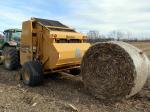COLUMBIA, Mo. — Cool-season lawns should be reseeded and fertilized by mid-October, says a University of Missouri Extension turf pathologist.
Many Missouri lawns received extensive drought damage this summer, but there are steps lawn owners can take to assure a lush, green lawn that will be the envy of the neighborhood next spring, said Lee Miller.
Homeowners have several options to increase their chances of repairing damage done to their lawns by the prolonged 2012 summer.
“Now is the time to aerify and dethatch,” Miller said.
Vertical slicers, aerifiers and dethatchers are available at local rental centers, or you could hire a lawn care service to do the work.
Vertical slicers make small, angular cuts into the ground, pulling out moisture-absorbing thatch and allowing more water, air and nutrients to reach roots.
Solid-tine aerifiers punch holes in the ground to aerify soil, while core aerifiers pull soil and thatch plugs out of the ground. Of the two aerifier types, Miller prefers core aerifying to remove thatch plugs.
Once the ground has been detached or aerated, the ground can be seeded. Miller recommends that gardeners use a heavy metal rake to remove dead grass and organic material. This allows for proper seed-to-soil contact and increases the likelihood of seeds taking root.
Once this seedbed has been prepared, it can then be reseeded. “Seed is available in a variety of blends of tall fescue cultivars or mixtures of tall fescue and Kentucky bluegrass that perform well in Missouri,” Miller said.
Buyers should read all seed labels completely to make sure that the seed mixture does not contain weeds or undesirable turfgrass species, such as annual ryegrass.
Turf-type tall fescues should be overseeded around 5-7 pounds per 1,000 square feet.
Miller recommends the following tips prior to reseeding:
- Mow the lawn closely (1.5 inches or less) just before reseeding, and remove grass clippings. If complete lawn renovation is necessary, spray a nonselective herbicide such as Roundup and then prepare the seedbed.
- Apply a starter fertilizer with phosphorus in it just before preparing the seedbed. Starter fertilizers normally contain a fairly balanced nitrogen-phosphorus-potassium ratio (20-20-20 or similar).
- Prepare the seedbed by raking heavily with a strong-tined metal rake, or using a vertical slicer, aerifier or shallow tiller (2 inches deep or less). If possible, go over the area two or three times in different directions.
- Spread the seed with a rotary or drop seeder. Most labels on seed bags bought in stores will give the proper setting for the type of spreader and seed you are using. For best results, use half the rate and go in two directions.
- Rake the area lightly after seeding to help cover the seed with soil. You can place wheat straw on top to protect seed and retain moisture.
- Water frequently until established. Most newly seeded lawns need to be lightly watered at least three or four times per week, Miller said. Established turf should be watered more deeply and infrequently.
Miller also recommends that homeowners buy their seeds now. Seeds may be in shorter supply later in the seeding season, resulting in a price increase.
Whether or not you are seeding, Miller says this is the perfect time to fertilize cool-season lawns. On established lawns, no phosphorus is necessary, but now is the time for heavy nitrogen application. Miller suggests one pound of nitrogen for every 1,000 square feet of ground. Cool-season lawns should be fertilized now with a full pound of nitrogen, and again in mid-October for optimum results.
If you have a zoysiagrass lawn, do not attempt to sod now, Miller said. Zoysiagrass, a warm-weather grass, should be sodded next spring when subsequent warm temperatures will allow for better growth and establishment. Also, it is crucial not to aerify or fertilize zoysiagrass lawns now, as it will encourage outbreaks of a disease called large patch.
While recent rains have brightened lawns, Miller said homeowners should not overlook the importance of fall lawn care or inspecting lawns for weeds and diseases. “Along with renovation, now is the best time to control broadleaf weeds. However, if a herbicide is used, be sure to read the herbicide label to see how long before or after application is necessary before turfgrass seeding.”
For more information, go to the MU Turfgass Science website at turf.missouri.edu. The site includes contact information for Miller and Brad Fresenburg, extension turfgrass specialist and research associate at MU.
Read more http://extension.missouri.edu/news/DisplayStory.aspx?N=1530






